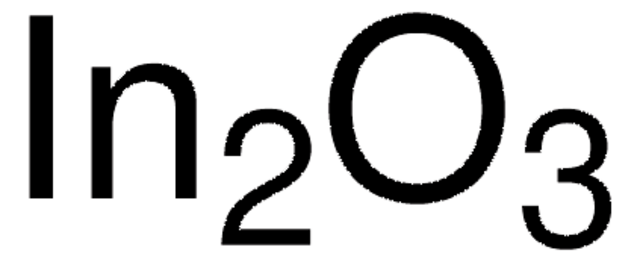289418
Indium(III) oxide
99.99% trace metals basis
Sinónimos:
Diindium trioxide, Indium sesquioxide
About This Item
Productos recomendados
presión de vapor
<0.01 mmHg ( 25 °C)
Ensayo
99.99% trace metals basis
Formulario
powder
idoneidad de la reacción
reagent type: catalyst
core: indium
densidad
7.18 g/mL at 25 °C (lit.)
aplicaciones
battery manufacturing
cadena SMILES
O=[In]O[In]=O
InChI
1S/2In.3O
Clave InChI
SHTGRZNPWBITMM-UHFFFAOYSA-N
¿Está buscando productos similares? Visita Guía de comparación de productos
Descripción general
Aplicación
- Comparative analysis on application conditions of indium (III) oxide-reinforced glasses in nuclear waste management and source transportation: A Monte Carlo study: This research explores the use of indium (III) oxide-reinforced glass for radioactive waste containment, highlighting its effectiveness and potential in nuclear waste management (ALMisned et al., 2023).
- Double-shelled hollow rods assembled from nitrogen/sulfur-codoped carbon coated indium oxide nanoparticles as excellent photocatalysts: Discusses the synthesis and application of indium oxide nanoparticles in photocatalysis, demonstrating significant enhancements in environmental cleanup technologies (Sun et al., 2019).
- Black indium oxide a photothermal CO2 hydrogenation catalyst: Investigates black indium oxide for its use in photocatalytic CO2 reduction, a critical process for sustainable energy and chemical synthesis (Wang et al., 2020).
- Material proposal for 2D indium oxide: This study proposes two-dimensional indium oxide, discussing its material characteristics and potential applications in electronics and optoelectronics (Kakanakova-Georgieva et al., 2021).
- Purification of indium by solvent extraction with undiluted ionic liquids: Examines the processes of extracting and purifying indium using green chemistry approaches, contributing to more sustainable practices in materials processing (Deferm et al., 2016).
Código de clase de almacenamiento
11 - Combustible Solids
Clase de riesgo para el agua (WGK)
WGK 3
Punto de inflamabilidad (°F)
Not applicable
Punto de inflamabilidad (°C)
Not applicable
Equipo de protección personal
dust mask type N95 (US), Eyeshields, Gloves
Elija entre una de las versiones más recientes:
¿Ya tiene este producto?
Encuentre la documentación para los productos que ha comprado recientemente en la Biblioteca de documentos.
Los clientes también vieron
Artículos
Spectral conversion for solar cells is an emerging concept in the field of photovoltaics, and it has the potential to increase significantly the efficiency of solar cells. Lanthanide ions are ideal candidates for spectral conversion, due to their high luminescence efficiencies and rich energy level structure that allows for great flexibility in the upconversion and downconversion of photons in a wide spectral region (NIR-VIS-UV).
Nuestro equipo de científicos tiene experiencia en todas las áreas de investigación: Ciencias de la vida, Ciencia de los materiales, Síntesis química, Cromatografía, Analítica y muchas otras.
Póngase en contacto con el Servicio técnico










